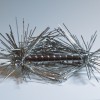Why Are Certain Materials Magnetic?
Magnets are everywhere, from the fridge door to your headphones, but have you ever wondered why certain materials are magnetic while others are not? The answer lies in the structure of atoms and the behavior of their electrons.
The Science Behind Magnetism
Atoms are made up of protons, neutrons, and electrons. Electrons orbit the nucleus and also “spin.” These tiny spins create a magnetic field.
In most materials, these spins point in random directions, canceling each other out. However, in magnetic materials like iron, cobalt, and nickel, the electron spins can align in the same direction, creating strong areas of magnetism known as domains.
When many domains align, the material becomes magnetized. That’s why a piece of iron can be turned into a magnet but a piece of wood cannot.
Common Magnetic Materials
- Iron: The most well-known magnetic metal, used in everything from tools to electromagnets.
- Cobalt: Strong and durable, often used in specialized magnetic alloys.
- Nickel: Found in everyday items like coins and batteries, and also used to make magnets stronger.
- Rare Earth Materials: Neodymium and samarium cobalt create the most powerful permanent magnets available today.
Everyday Uses of Magnetic Materials
From keeping your refrigerator door closed to powering electric motors, magnets are central to modern life. Even medical equipment like MRI machines relies on strong magnetic fields to create detailed images inside the body.
Understanding Magnetic Materials
So, why are certain materials magnetic? It all comes down to the way their electrons spin and align. Materials like iron, cobalt, nickel, and rare earth elements have atomic structures that allow them to generate strong magnetic fields, making them essential to countless tools, technologies, and everyday conveniences.
Want to explore magnets for your own projects? Check out our wide selection of neodymium, ceramic, and specialty magnets at ApexMagnets.com. Subscribe to our monthly newsletter to be among the first to receive notifications about our latest blogs and our latest magnet deals.
Safety Warning: Children should not be allowed to play with neodymium magnets as they can be dangerous. Small magnets pose a choking hazard and should never be swallowed or inserted into any part of the body.
Magnets can be dangerous. Neodymium magnets, especially, must be handled with care to avoid personal injury and damage to the magnets. Fingers and other body parts can get severely pinched between two attracting magnets. Bones can be broken by larger magnets. Visit our Magnet Safety page to learn more.

